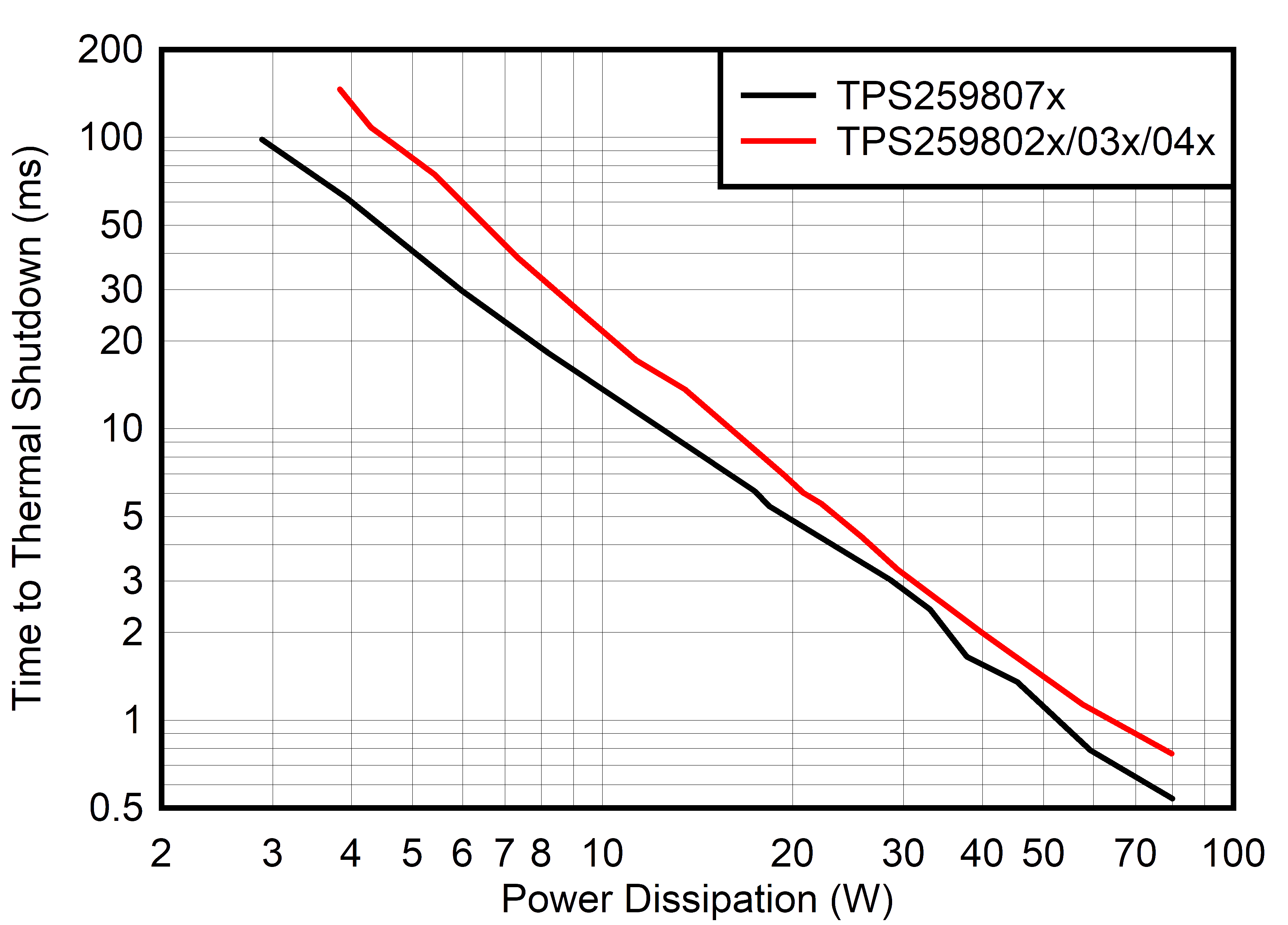SLVSFR1 August 2020 TPS25980
PRODUCTION DATA
- 1 Features
- 2 Applications
- 3 Description
- 4 Revision History
- 5 Device Comparison Table
- 6 Pin Configuration and Functions
- 7 Specifications
-
8 Detailed Description
- 8.1 Overview
- 8.2 Functional Block Diagram
- 8.3 Feature Description
- 8.4 Fault Response
- 8.5 Device Functional Modes
-
9 Application and Implementation
- 9.1 Application Information
- 9.2
Typical Application: Patient Monitoring System in Medical Applications
- 9.2.1 Design Requirements
- 9.2.2
Detailed Design Procedure
- 9.2.2.1 Device Selection
- 9.2.2.2 Setting the Current Limit Threshold: RILIM Selection
- 9.2.2.3 Setting the Undervoltage Lockout Set Point
- 9.2.2.4 Choosing the Current Monitoring Resistor: RIMON
- 9.2.2.5 Setting the Output Voltage Ramp Time (TdVdt)
- 9.2.2.6 Setting the Load Handshake (LDSTRT) Delay
- 9.2.2.7 Setting the Transient Overcurrent Blanking Interval (tITIMER)
- 9.2.2.8 Setting the Auto-Retry Delay and Number of Retries
- 9.2.3 Application Curves
- 9.3 System Examples
- 10Power Supply Recommendations
- 11Layout
- 12Device and Documentation Support
- 13Mechanical, Packaging, and Orderable Information
9.2.2.5.2 Case 2: Start-Up With Load: Output Capacitance COUT and Load Draw Current
When the load draws current during the turn-on sequence, there is additional power dissipated. Considering a resistive load during start-up RL(SU), load current ramps up proportionally with increase in output voltage during TdVdt time. Equation 16 shows the average power dissipation in the internal FET during charging time due to resistive load.

Equation 17 gives the total power dissipated in the device during start-up

The power dissipation, with and without load, for selected start-up time must not exceed the start-up thermal shutdown limits as shown in Thermal Shutdown Plot During Start-up
 Figure 9-2 Thermal Shutdown Plot During Start-up
Figure 9-2 Thermal Shutdown Plot During Start-upFor the design example under discussion, the output voltage has to be ramped up in 20 ms, which mandates a slew-rate of 0.6 V/ms for a 12 V rail.
The required CdVdt capacitance on dVdt pin to set 0.6 V/ms slew rate can be calculated using Equation 18

The dVdt capacitor is subjected to typically VIN+ 4 V during startup. The high voltage bias leads to a drop in the effective capacitor value. So, it is suggested to choose 20% higher than the calculated value, which gives 9.2 nF. Choose closest 10% standard value: 10 nF
The 10 nF CdVdt capacitance sets a slew-rate of 0.46 V/ms and output ramp time TdVdt of 26 ms.
The inrush current drawn by the load capacitance COUT during ramp-up can be calculated using Equation 19

The inrush power dissipation can be calculated using Equation 20

For 3.9 W of power loss, the thermal shutdown time of the device must be greater than the ramp-up time TdVdt to ensure a successful start-up. Figure 9-2 shows the start-up thermal shutdown limit. For 3.9 W of power, the shutdown time is approximately 100 ms. So it is safe to use 26 ms as the start-up time without any load on the output.
The additional power dissipation when a 10-Ω load is present during start-up is calculated using Equation 21

The total device power dissipation during start-up can be calculated using Equation 22

From Thermal Shutdown Plot During Start-up, the thermal shutdown time for 6.3 W is approximately 40 ms. It is safe to have 30% margin to allow for variation of system parameters such as load, component tolerance, and input voltage. So it is well within acceptable limits to use the 10 nF for CdVdt capacitor with start-up load of 10 Ω.
When COUT is large, there is a need to decrease the power dissipation during start-up. This can be done by increasing the value of the CdVdt capacitor. A spreadsheet tool TPS25980xx Design Calculator available on the web can be used for iterative calculations.